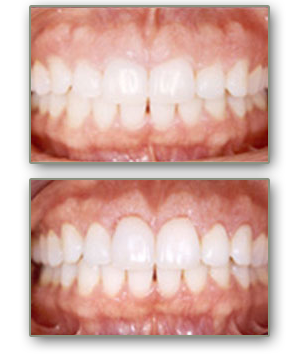Dental Procedures
Cosmetic Gum Sculpting

The "gummy smile" is one of the most overlooked conditions in dentistry. Patients usually accept this condition thinking they just have short teeth. The problem is not short teeth but, most often, too much gum tissue. The excess gum tissue covers the unexposed enamel resulting in a "gummy smile." Crown-lengthening exposes more of the natural tooth by reshaping or recontouring bone and gum tissue. Crown-lengthening procedures can also be used to correct a "gummy" smile, where teeth are covered with excess gum tissue.
Extra gum tissue can make teeth look unnaturally short, and also increase susceptibility to periodontal infections. Removing excess gum tissue can restore a balanced, healthy look and thus improve the aesthetic appearance of the smile.
This treatment can be performed on a single tooth, many teeth or the entire gum line to expose a pleasant, aesthetically pleasing smile.
The diagnosis for these patients is "altered passive eruption." These patients often have excessive bone height and thickness that result in a higher location of the gingival margin. "Lifting" the gums to the CEJ can make a dramatic improvement in the smile. The cosmetic dentist must be keenly aware of how the gums "frame" the teeth. The best esthetic results will only be achieved if all components of the smile are properly evaluated.
Crown Lengthening
Crown lengthening is generally performed in order to improve the health of the gum tissue, or to prepare the mouth for restorative or cosmetic procedures.
Reasons for crown lengthening
Crown lengthening is a versatile and common procedure that has many effective uses and benefits. The vast majority of patients who have undergone this type of surgery are highly delighted with the results.
What does crown lengthening involve?
Dr. Simone will determine the amount of tissue to be removed. He will refer you to an extremely talented periodontist—either Dr. Gifford or Dr. Trylovich—who will perform the procedure. Crown lengthening is normally performed under local anesthetic. The amount of time this procedure takes will depend largely on how many teeth are involved and whether a small amount of bone needs to be removed, in addition to the soft tissue.
Dr. Simone will make a series of small incisions around the soft tissue in order to separate the gums from the teeth. Even if only one tooth requires the re-contour, neighboring teeth are usually treated to provide a more even reshaping. Separating the gums provides the dentist with access to the roots of the teeth and the underlying bone.
In some cases, the removal of a small amount of tissue will provide enough tooth exposure to place a crown. In other cases, the dentist will also need to remove a small amount of bone from around the teeth. The bone is usually removed using a combination of special hand instruments, and rotary instruments. The rotary instruments roughly resemble the drill that is used in cavity treatment.
When Dr. Simone is satisfied the teeth have sufficient exposure, the wound will be cleaned with sterile water and the gum tissue will be sutured with small stitches. The teeth will look noticeably longer immediately after surgery because the gums have been repositioned.
Dr. Simone will secure the surgical site using an intraoral (periodontal) bandage, which serves to prevent infection. Prescriptions may be provided for pain medication, and a chlorhexidine (antimicrobial) mouth rinse may be given to help reduce any bacteria attempting to re-colonize. The surgical site will be completely healed in approximately two to three months.
